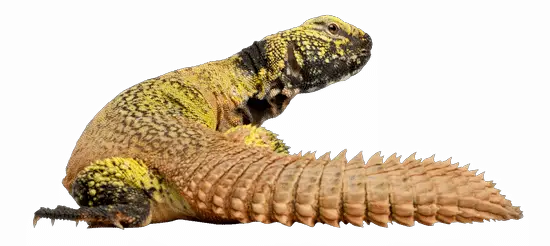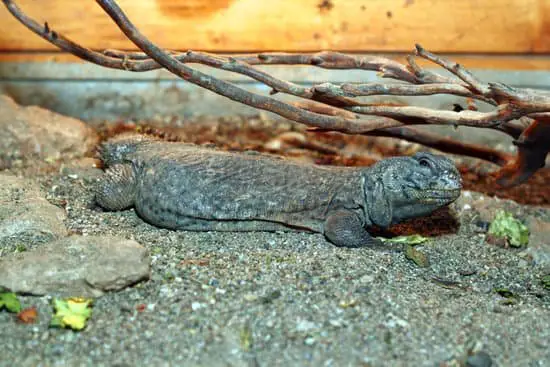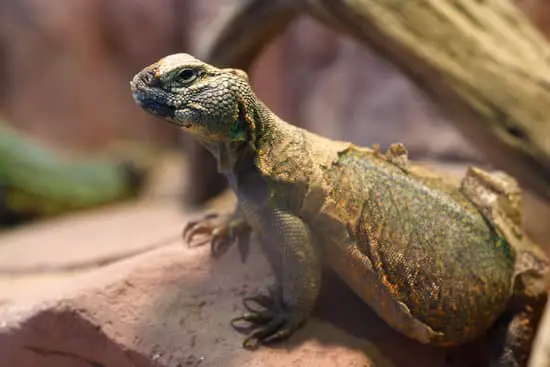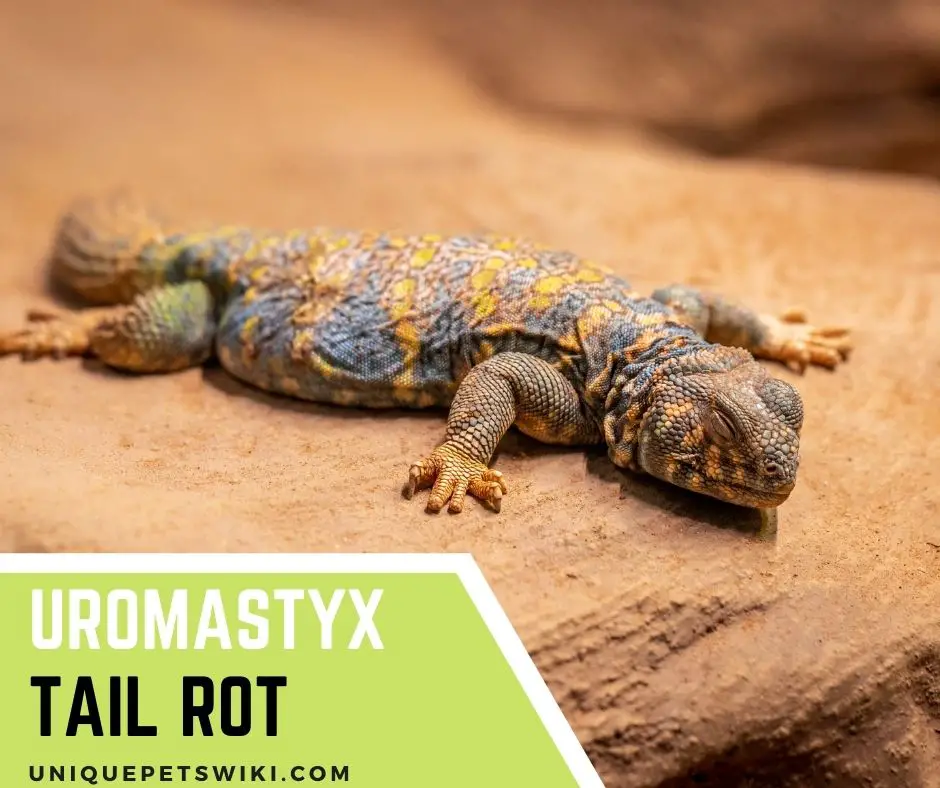Tail rotting is a common medical issue with uromastyx. While they are known for their beautiful, spiny tails, their slender ends can rot and die due to a variety of reasons. Caretakers of such reptiles grow concerned over this as they frequently question why this is starting to happen and if it is permanent or curable.
Uromastyx tails may darken and eventually fall if not treated, and this article contains how to spot tail rot, explain why it is happening, and how to deal with it.
This article has been reviewed by Dr. Gospel. Read more about our knowledge control process here.
Contents
What Is Tail Rot in Reptile?
Uromastyx lizards have a huge belly, broad spiky tail, strong limbs, rounded skulls, and protruding cheeks. The form and length of the tail differ according to the species.
This species can be found in a variety of colors and patterns such as red, orange, yellow, green, blue, brown, black, or white. You will also notice that males are more colorful than females.
Tail rot is a common medical problem observed in reptiles, particularly uromastyx. It can be told apart from shedding as the uromastyx may develop flaky, brittle, or coarse textures on the affected parts of its tail. Shedding is when they dispose of their old skin and grow it out with a new one.
Tail rot is more of an issue within the body, and thus, it cannot be contracted from spreading. It is not contagious to other divisions, however, it can spread out from the affected part if it is left untreated or not immediately attended to.
Tail rot will not go away on its own because when the affected part of the tail or the tip begins to decay, evidenced by discoloration, it will rapidly spread out and cause it to fall off eventually. The uromastyx will not be able to grow its tail back, especially if infection, organ failure, or other health issues are already present.

Signs Of Uromastyx Tail Rot
The most common signs of tail rot are the development of a different and unusual color, starting from the tip, and dryness. Tail rot may be caused by too much moisture in the enclosure, failing to dry after soaking, infection, and stuck skin.
To manage tail rot, a proper consultation must be set with a veterinarian to identify the immediate causes and solutions.
Does Tail Rot Affect Your Uromastyx Health?
In the wild, the weak get to be easily taken out or preyed on which is why reptiles, uromastyx particularly, are good at masking their ill conditions. With this, spotting a tail rot may be difficult.
Not instantly or immediately noticing this will harm their health as the affected area may spread throughout the entire tail. This can also threaten the surrounding or other systems in the body which allows illnesses to develop.
Several health issues can be prevented with good husbandry. Maintaining a dry enclosure, suitable substrate, proper temperature, basking areas, and adequate space contribute to keeping the uromastyx healthy.
Causes Of Uromastyx Tail Rot
The reason for tail rot in your pet uromastyx may be discovered after evaluating the signs. This might be caused by a necrotic tissue that is dying or dead without an adequate supply of blood. Tail rot is normally attributable to the moist enclosure, infection, stuck skin from shedding, and failing to dry them off after soaking.
An Enclosure That Is Too Moist
Tail rot can be the result of keeping an excessively moist enclosure for your uromastyx. Uromastyx are found in highly hot and dry regions, and they only require little humidity. Tail rot and other skin illnesses, as well as respiratory infection, can be caused by high humidity levels or too much water on their skin.
For a uromastyx, humidity levels of 20-30% are optimum. It can reach 40% at night, but should not be sustained for lengthy periods. As the caretaker of the uromastyx, you must be aware that the state of the enclosure can be greatly influenced by the surrounding environment.
Consider placing the enclosure in a warmer, drier location if the area where your pet is kept is prone to dampness. Even deep desert lizards like the uromastyx require a little more humid environment in which to repose.
Reduce the humidity but not to the point where your pet is unable to fully function or feels uncomfortable.

Failing To Dry Them Off After A Soak
As mentioned, they thrive in warmer regions, the condition where they feel most comfortable. Thus, they do not need too much water on their skin. With the accumulated water left on them by failing to dry them off after soaking, tail rot is bound to happen.
If your uromastyx is not dehydrated, do not soak or spray it to avoid tail rot. If you want to add moisture, sprinkle their food with water first thing in the morning. Once a week, you may also leave a shallow water dish for your uromastyx to sip from. These will help prevent excessive moisture and tail rot.
Stuck Skin From Shedding
Blood circulation in the tail can be disrupted by having skin stuck on the tail from shedding. Uromastyx under the age of two years may shed every month or two, but with age, they will shed less frequently, once every three to six months.
Adult uromastyx over the age of 3-4 years will shed once or twice a year. The accumulation of the shed might impair blood circulation, resulting in a darker hue and decaying on the tail.

Either Bacterial Or Fungal Infections
Tail rot in uromastyx can be either be caused by bacterial or fungal diseases that can develop in the spiny tail’s damp crevices.
As mentioned, they do not need excess moisture in their body as dry and warm conditions are most suitable for them. This also denotes the importance of drying after soaking, to prevent further infections and tail rot.
How To Deal With Tail Rot In Uromastyx?
In general, tail rot can only be prevented, not reversed. Thus, when the uromastyx has a dying tail, it is best to take it to the veterinarian for a check-up, to determine the cause/s, and arrangement of rot management.
It poses harm to the uromastyx because not getting the right and appropriate treatment can lead to its death from infection or health complications.
If the area with discoloration or dryness cannot be treated anymore, the tail has to be cut off to prevent further spreading and the development of serious health risks.
The following are the basic steps of dealing with tail rot in your uromastyx:
- Inspect the affected area. You will notice the discoloration along the tail (turning black or dark). It will also appear dehydrated or flaky. You may break it off at the fracture point to prevent further death of the tail, only make sure that it is bendable and not wet.
- If unsupervised or handled on your own, breaking off at the fracture point may be too difficult and risky. Consult a veterinarian right away so the important steps of dealing with it will not be missed.
- If the majority of the tail is already dying, the vet may suggest amputation. Do not try this by yourself as this needs to be done by a licensed attendant.
First, Disinfect The Tail Wound
You have to determine the main cause of tail rot first to address the issue at hand. Small discoloration and minor damage are examples of instances that can be treated at home.
By treating the damaged region right away, you can avoid additional infection and aggravation of the wound. Breaking it off at the fracture site can help. It is critical to remember to clean the wound at all times for it to recover.
Antibiotics and 3-4 times daily cleaning with diluted betadine and water may be sufficient for treatment. The antibiotic Neosporin is a solid option.
However, if the tail rot has spread and become severe, the requirements of your uromastyx must be attended to by a veterinarian immediately.
See A Veterinarian And Surgery Your Uromastyx
When the tail rot has gotten far severe and home remedies or adjustments will not help, a vet must be consulted as soon as possible.
Antibiotics may be used to treat the infection if it can be managed without removing the affected area. However, antibiotics may be tough on the uromastyx organs, so you should get a precise diagnosis.
You must keep it well hydrated so that it can properly handle the drug. To avoid appetite suppression, the veterinarian may provide an immunity booster.
If the tail rot has developed and appears to be threatening to the uromastyx, the vet may perform surgery. Expect to lose half an inch or more. It is, however, upon your discretion and approval since you will be asked if you are okay with the length.
In sterile settings, the vet may prescribe an anesthetic for amputation or abscess removal.
Will Your Uromastyx’s Tail Grow Back?
While some lizards can regenerate their tails, unfortunately, for uromastyx, they cannot grow their tails once removed or fallen off. Nonetheless, they can still live healthily with the tail gone, especially when provided with the proper and befitting conditions.
FAQs
Can uromastyx lose their tail?
No, a uromastyx is not capable of “dropping” its tail.
How can you tell if your uromastyx is dehydrated?
Owners will notice that their uromastyx would appear lethargic, inactive, with sunken eyes and wrinkled skin. These indicate that their pet is dehydrated.
What does tail rot look like on a uromastyx?
The tail will have a rotten look, like how the name suggests. There will be evident discoloration on their spiny tails which will start at the tip and work their way up if not treated immediately. It will look hard and dry as well.
Can you soak a uromastyx?
Yes, they can be soaked once a day in warm water and most especially if they had a stuck shed. However, they require supervision or monitoring to make sure that the head is out of the water.
Conclusion
Overall, it is important to observe your pet uromastyx to see anything unusual. Physical manifestations often tell what could be wrong or unhealthy with your pet. With quick recognition of such abnormalities, you will be able to address the issue and keep your pet happy and healthy as soon as possible.
Tail rot is a common medical issue. It can only be prevented, not reversed. Moreover, it can also be both risky and painful for your pet.
This can be caused by a variety of factors, including stuck skin from shedding and infection in the tail. While home cures are available, it is still recommended that you visit a veterinarian for the best precise diagnosis and treatment for your uromastyx’ health and safety.
